TriplePundit • Are Low-Emission Zones Freeing European Cities from Smog?

European cities are famed for clean streets and well-maintained historic architecture, but these lovely spaces can be overshadowed by dirty skies. For decades, smog has ruled the air in cities like Paris, Brussels and Warsaw. This throat-burning, eye-stinging pollution can lead to long-term health problems. Much of the pollution comes from vehicles.
Some cities responded by implementing low-emission zones (LEZs). These zones regulate the presence of polluting vehicles in populated areas, often by banning older gas-fueled vehicles or restricting how often they’re allowed to enter.
Low-emission zones are a tricky solution. At worst, they can inadvertently punish people for driving cars they can’t afford to replace. But at best, they can be part of an equitable transition to cleaner, healthier cities, with benefits for residents, commuters and visitors.
Leading the LEZ charge
Europe already has over 300 low-emission zones in place. That’s largely because of the European Union’s Ambient Air Quality Directive, a policy system to address pollution. “It basically sets limits on different pollutant emissions, and the member states have to meet these air quality limits,” said Kaylin Lee, a researcher on the Europe team at the International Council on Clean Transportation. “If they don’t meet the limits in certain areas, they have to plan a road map to meet the air quality limits.”
While the Air Quality Directive doesn’t expressly require low-emission zones, they can be a useful part of a country’s road map. “In large cities, like Warsaw or Kraków, the main source of pollution is transport, which is responsible for about 75 percent of emissions of toxic nitrogen oxides,” said Katarzyna Kalinowska, digital and communications officer of Clean Cities Campaign Poland.
Air pollution isn’t just uncomfortable to be around — it actually poses serious health risks. The World Health Organization estimates it leads to about 7 million premature deaths annually. That means reducing pollution saves lives and relieves undue burden on healthcare systems. Low-emission zones can help, but they come with potential roadblocks to navigate.
Lessons from Brussels
Belgium’s capital city, Brussels, established a low-emission zone in 2018. The restrictions on vehicles are gradual, giving drivers time to adapt. “Every two or three years, [cars with] the oldest engines can’t drive anymore in the zone,” said Pierre Dornier, director of the Belgian nonprofit Les Chercheurs d’Air (The Air Seekers).
Though gradual, the change is already reducing pollution. Nitrogen oxide levels in Brussels fell by 36 percent in the program’s first five years, according to a 2023 assessment. The Brussels low-emission zone is citywide, but in 2025, a team of researchers found that the air quality improvements stretch as far as 5 kilometers away.
The fact that many people in European cities already don’t drive makes implementation easier, Dornier explained. “For example, in Brussels, 56 percent of the population doesn’t own any car,” he said, adding that new restrictions could also inspire more drivers to swap cars for alternatives like bicycles or public transit.
But some people who need to drive can’t afford an LEZ-compliant electric vehicle. “It’s also important to have equity considerations in mind,” said Sandra Wappelhorst, a research lead at the International Council on Clean Transportation Europe.
Low-emission zones work best when compliance is accessible to everyone. As Dornier puts it, it’s up to governments to “really provide solutions before saying, ‘Okay, we don’t want you to drive your car around anymore.’”
In Brussels, when someone sells their old car, they can receive public money to help with taxi and public transit fares or the cost of a bike. “There is a really big plan in place to incentivize you to get rid of your car and to have alternatives,” Dornier said.
In countries including Greece and Italy, the government will even help fund the cost of an electric vehicle. Incentives like these can help new LEZs be more effective, making compliance both accessible and appealing.
Exceptions are important for equity, too. For example, Dornier said he supports automatically exempting drivers with mobility issues from LEZ restrictions. The Brussels government also offers a limited annual number of day passes that drivers can purchase to enter the city with any vehicle, including those that don’t meet the LEZ regulations. Through a balance of restrictions and flexibility, LEZs can meet air pollution targets without needlessly punishing drivers.
LEZs face growing pains in Kraków and Warsaw
Though it’s still a work in progress, Brussels has had years to fine-tune its low-emission zone program. Meanwhile, Poland’s largest cities are Europe’s LEZ newcomers.
Warsaw’s zone went into effect just over a year ago, and Kraków’s will begin in January 2026. “Recent public opinion research shows that 63 percent of Warsaw residents support the introduction of the low-emission zone,” said Kalinowska of Clean Cities Campaign Poland.
Still, the implementation was not smooth. “There was very strong opposition, especially among members of right-wing parties in Poland,” said Piotr Siergiej, press officer of the nonprofit Polish Smog Alert.
So, city leaders decided to compromise. Warsaw ended up with a zone that covers just 7 percent of the city and still allows decades-old vehicles inside, even though aging engines often have high emissions. For Warsaw residents, the restrictions don’t apply until 2028. For now, only visitors and commuters need to comply. “Every two years, the restrictions will be stronger and stronger,” Siergiej said.
This is much like the gradual approach in Brussels, but while the Brussels zone is citywide, Warsaw’s only covers a small section of downtown. So far, the small zone size and limited restrictions mean Warsaw’s air quality hasn’t really improved, Siergiej said. Drivers can easily drive around the small zone with polluting vehicles, and that pollution still reaches the city center where the low-emission zone is.
To make effective LEZs, it’s important for governments to consider both size and placement. If major roads through a city or region don’t pass through the low-emission zone, it’s easy for drivers to bypass restrictions.
Complexity can be another barrier to success. “Currently, it is possible to enter the [Warsaw] zone up to four times a year with a vehicle that does not meet the requirements, and only on the fifth entry should a fine be issued,” Kalinowska said.
These rules are tricky to comply with and challenging to enforce. It’s all too easy for drivers to lose track of how many times they’ve entered with a non-compliant vehicle, and there is not an effective way for the city to track violations. “Fortunately, cities are in communication with one another, and the mistakes made during the implementation of the LEZ in Warsaw are being taken into account in Kraków. There, the system is expected to be simpler,” Kalinowska said.
When new LEZs are adopted, early communication can help win residents over. “A lot of this public pushback comes from the fact that they’re not so aware of the air quality benefits of a low-emission zone or what are the actual steps — like when they should change their cars, or if there are other policy measures they could leverage to help them transition or get a cleaner car,” said Lee of the International Council on Clean Transportation. “If they are not aware of these, that definitely makes it more difficult [for the program] to be accepted and effective, so I think communication is a really important piece.”
Building a better system
Governments considering creating low-emission zones can take valuable lessons from what has and hasn’t worked in other regions. But there’s an issue the LEZ concept hasn’t yet addressed: “It answers the air pollution issue, but it doesn’t do anything about the weight and the size of vehicles,” said Dornier of Les Chercheurs d’Air.
Many electric vehicles, for example, are heavier than gas-fueled vehicles due to the weight of their batteries. Increasingly-popular, large and powerful EVs require heavier batteries. That additional weight can increase another type of vehicle pollution: “ultra-fine particulate matter coming from the wear of tires and of the brakes,” Dornier said.
And though a low-emission zone might keep larger gas-fueled vehicles off Europe’s famously narrow roadways, sharing the road with large electric SUVs and trucks can still be risky and challenging for cyclists, pedestrians and bus drivers, he added.
No region has yet perfected the low-emission zone strategy, but flexible and incentive-driven programs like the one in Brussels show promise for reducing air pollution while meeting the needs of large populations. Experts say effective low-emission zones should come with a choice of safe, accessible and healthy transportation options, rather than restricting people to a single type of car. “We live in big cities with a lot of diversity,” Dornier says. “You can’t just have one route for everybody.”



Post Comment